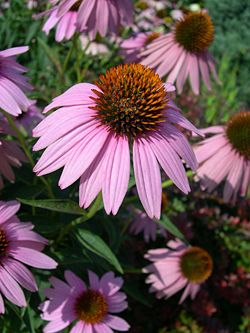Echinacea
Echinacea, also called coneflower or rudbeckia purpurea, is a "genus of perennial herbs used topically and internally. It contains echinacoside, glycosides; inulin; isobutyl amides, resin, and sesquiterpenes."[1]
Botany
The echinacea genus is in the aster family.[2] The genus contains nine species including E. angustifolia (blacksamson echinacea) and E. purpurea (eastern purple coneflower). E. angustifolia grows in the central United States.[3] E. purpurea grows in the eastern United States except for northern New England.[4]
Role in health care
Common cold
There is no role for echinacea in treating or preventing the common cold according to most systematic reviews[5][6] of randomized controlled trials.[7][8] An additional randomized controlled trial found no benefit in experimentally induced rhinovirus infection.[9] A meta-analysis by the Cochrane Collaboration concluded there may be a role for the aerial parts of Echinacea purpurea that needs further study.[5]
More recently, a meta-analysis concluded that echinacea may help in both prevention and reducing duration.[10] This meta-analysis did not study the effect on the severity of cold symptoms. This is difficult to interpret as two of the best studies,[8][9] that used placebos designed to mimic the taste and texture of the echinacea, were both negative. In addition, this meta-analysis reported funnel plot asymmetry which notes its results may be affected by publication bias against negative studies.
References
- ↑ Anonymous (2025), Echinacea (English). Medical Subject Headings. U.S. National Library of Medicine.
- ↑ USDA. Classification for Kingdom Plantae Down to Genus Echinacea Moench. USDA Plants. Retrieved on 2008-02-03.
- ↑ USDA. PLANTS Profile for Echinacea angustifolia (blacksamson echinacea). USDA PLANTS. Retrieved on 2008-02-03.
- ↑ Anonymous. PLANTS Profile for Echinacea purpurea (eastern purple coneflower). USDA PLANTS. Retrieved on 2008-02-03.
- ↑ Jump up to: 5.0 5.1 Linde K, Barrett B, Wölkart K, Bauer R, Melchart D (2006). "Echinacea for preventing and treating the common cold". Cochrane Database Syst Rev (1): CD000530. DOI:10.1002/14651858.CD000530.pub2. PMID 16437427. Research Blogging. “some evidence that preparations based on the aerial parts of Echinacea purpurea might be effective for the early treatment of colds in adults but results are not fully consistent”
- ↑ Arroll B (2006). "Common cold". Clin Evid (15): 2006–14. PMID 16973075. [e]
- ↑ Yale SH, Liu K (2004). "Echinacea purpurea therapy for the treatment of the common cold: a randomized, double-blind, placebo-controlled clinical trial". Arch. Intern. Med. 164 (11): 1237–41. DOI:10.1001/archinte.164.11.1237. PMID 15197051. Research Blogging.
- ↑ Jump up to: 8.0 8.1 Barrett BP, Brown RL, Locken K, Maberry R, Bobula JA, D'Alessio D (2002). "Treatment of the common cold with unrefined echinacea. A randomized, double-blind, placebo-controlled trial". Ann. Intern. Med. 137 (12): 939–46. PMID 12484708. [e]
- ↑ Jump up to: 9.0 9.1 Turner RB, Bauer R, Woelkart K, Hulsey TC, Gangemi JD (2005). "An evaluation of Echinacea angustifolia in experimental rhinovirus infections". N. Engl. J. Med. 353 (4): 341–8. DOI:10.1056/NEJMoa044441. PMID 16049208. Research Blogging.
- ↑ Shah SA, Sander S, White CM, Rinaldi M, Coleman CI (2007). "Evaluation of echinacea for the prevention and treatment of the common cold: a meta-analysis". Lancet Infect Dis 7 (7): 473–80. DOI:10.1016/S1473-3099(07)70160-3. PMID 17597571. Research Blogging.
